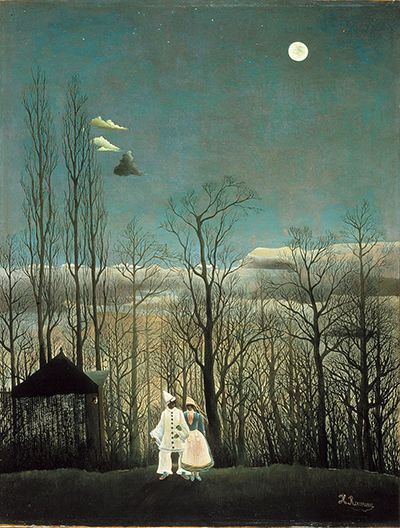Responding to Henri Rousseau's Carnival Evening
Here on the AnArt4Life blog we love hearing from our subscribers and social media followers as our aim is to share our interests in all things art around the world.
I have had a keen interest in naive art for a very long time and back in 2020 I wrote an analysis of Carnival Evening (below) painted by French artist Henri Julien Félix Rousseau (1844- 1910).
Rousseau was a French post-impressionist painter in the Naïve or Primitive manner. He was also known as Le Douanier (the customs officer), a humorous description of his occupation as a toll and tax collector. He started painting seriously in his early forties; by age 49, he had retired from his job to work on his art full-time.
Ridiculed during his lifetime by critics, he came to be recognized as a self-taught genius whose works are of high artistic quality. Rousseau's work exerted an extensive influence on several generations of avant-garde artists. 1
To read the original post please click here.

Recently I received the following correspondence from a Christopher H.L. (name provided) in response to reading the post I wrote on this painting.
I recently read your post about Henri Rousseau's Carnival Evening (Jun 14, 2020). It has always been one of my favorite works of art. As a teenager I had a poster of it on my wall.
To me, the disembodied face represents the artist himself, and perhaps there is a resemblance to Henri himself, perhaps representative of the artist's perspective, inside the work and yet detached in a way? The couple seemed to me to be almost ghostly. The man appears to be holding a drawing or writing implement in his right hand, so perhaps he is another representation of the artist? There seems to be an iron fence in the far left of the painting that extends to the building roof, with three cross-like spikes at the top. The building roof itself has a cross-like feature at the peak. The build is a bit odd, there is what appears to be a large brown tree-trunk at first on the right on which the face/head is located, it even has the apparent texture of a tree trunk, but then what is supporting the lighter portion of the roof? There appear to be two thin poles supporting the dark triangular roof section, which to me seems like perhaps it could be the tent-like canopy of a circus? The lamp seems to be attached to the lighter colored roof part and lights a portion of it. But the face seems to be lit by the moon.
All these parts to me along with the wintry leafless tress seems to be representing an artist's perspective on a relationship/love, glowing from within the couple but surrounded by a cold stark world, a lonely forest of now dead past relationships, perhaps, behind them.
There is also that one dark cloud in the sky, perhaps a coming storm cloud that will disrupt the couple's relationship.
The great thing about art is everyone can see in and get from a great work something that speaks to their inner feelings!
I chose to write the original post on the painting because of the use of light as an essential element.
When you first look at this painting it appears as a charming moonlight scene with a whimisical tone. But look carefully and you see that all is not well.
Thank you Christopher for going to the effort to share your thoughts and feelings about this painting. We value your contribution to our blog very much.
Credit
1. en.wikipedia.org
2 commons.wikimedia.org
Please consider leaving your comments about this unusual painting by Henri Rousseau.
